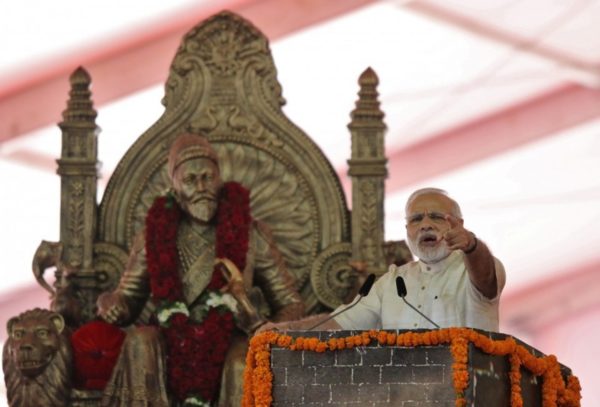India plans to build the world’s tallest statue, twice the height of the Statue of Liberty, honoring a 17th-century Hindu warrior king.
King Shivaji fought India’s Muslim Mughal empire in the 17th century and carved out a kingdom in the Maharashtra region near modern-day Mumbai.
Some Hindus credit him with establishing the “ideal Hindu kingdom,” one that revived many ancient traditions. He is particularly popular among the Hindu nationalists dominating India’s politics at the moment.
But the 630-foot statue, to be built on reclaimed land in the Arabian Sea off Mumbai, has prompted many Indians to reach for their calculators. They say the statue’s whopping budget of more than $525 million could be used for better things.
Over the weekend, when Prime Minister Narendra Modi laid the foundation stone for the statue — which will be completed by 2019 — it reminded Indians about another tall, bronze statue that he had promised two years ago. Modi had called it the “Statue of Unity,” and it was to be the world’s tallest statue, portraying Sardar Vallabhbhai Patel, one of the founding fathers of India, in his home state of Gujarat.
But now the Shivaji statue in the Arabian Sea is set to be about 26 feet taller.
In an open letter published in the Indian Express newspaper, Ujjal Dosanjh, a Canadian politician of Indian origin, wrote: “Dear Prime Minister: You are once again thrusting India into the dangerous politics of statues; the politics of pandering to regional and other identities; the politics of turning real heroes into the lifeless steel and stone kind — for any pigeons to freely relieve themselves on; the heinous politics of clever, but criminal distraction from the life and death issues of poverty, corruption, injustice and inequality in India.”
The Shivaji statue has been called “colossal and absurdly expensive,” one that shows that “India has no room for its tired, huddled masses.”
The debate over the statue comes at a particularly difficult time for many Indians, who are struggling with the fallout of Modi’s sudden currency swap two months ago. The decision has led to severe cash shortages, bank limits on withdrawals, an industrial slump and layoffs.
The cost of the statue is more than the budget for Mumbai’s schools and health care, many pointed out. In fact, it is more than the city municipal corporation’s annual budget.
Although Indian cities have come a long way in providing basic utilities, there are still severe shortcomings in clean water, power, health care and garbage disposal in many places.
An online petition against the Shivaji statue extravaganza said: “This is not what Shivaji would have wanted and I am sure we can find other ways to honor him.”
Critics have also said that the construction will affect fishing sites.
But the sculptor of the two statues, Ram Sutar, offered this counterargument:
“If people had worried about how much the Taj Mahal would cost, it would never have been built.”
This is not the first time that Indians have been outraged over statue budgets. A few years ago, many Indians questioned why a lower-caste politician and former chief minister of the state of Uttar Pradesh, Mayawati, had spent more than $800 million to build memorials and parks to commemorate leaders who fought against India’s caste system.
Also, in Uttar Pradesh, the world’s tallest religious structure is now under construction, a 700-foot Hindu temple complex that will include a theme park, an auditorium, a food court and a helipad.
Performing the prayer ceremony for the proposed Shivaji statue was “special,” and “many aspects of his personality inspire us,” Modi tweeted Saturday.
Tweets from other Indians, however, suggested that they were less enamored with the whole venture.






Leave a reply